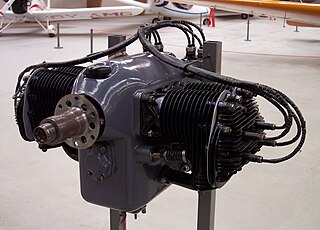Related Research Articles

The E-series was a line of inline four-cylinder automobile engines designed and built by Honda for use in their cars in the 1970s and 1980s. These engines were notable for the use of CVCC technology, introduced in the ED1 engine in the 1975 Civic, which met 1970s emissions standards without using a catalytic converter.

The Jabiru 2200 is a lightweight naturally aspirated, pushrod four-stroke, flat four, air-cooled aircraft engine produced by Jabiru Aircraft.

The Continental A40 engine is a carbureted four-cylinder, horizontally opposed, air-cooled aircraft engine that was developed especially for use in light aircraft by Continental Motors. It was produced between 1931 and 1941.

The Continental O-240 engine is a four-cylinder, horizontally opposed, air-cooled aircraft engine that was developed in the late 1960s for use in light aircraft by Continental Motors, Inc. The first O-240 was certified on 7 July 1971.

The Lycoming O-145 is a family of small, low-horsepower, four-cylinder, air-cooled engines. It was Lycoming Engines' first horizontally opposed aircraft engine and was produced from 1938 until the late 1940s. The family includes the reduction-geared GO-145. The O-145 received its Approved Type Certificate on 13 Jun 1938.

The Lycoming O-435 is an American six-cylinder, horizontally opposed fixed-wing aircraft and helicopter engine made by Lycoming Engines. The engine is a six-cylinder version of the four-cylinder Lycoming O-290.
The Rotax 277 is a 26 hp (19 kW), single-cylinder, two-stroke aircraft engine, that was built by BRP-Rotax GmbH & Co. KG of Austria for use in ultralight aircraft.
The Rotax 618 is a 73.8 hp (55 kW) two-stroke, two-cylinder, liquid cooled, gear reduction-drive engine that was formerly manufactured by BRP-Rotax GmbH & Co. KG. It was designed for use on ultralight aircraft.
The Hirth 2704 and 2706 are a family of in-line twin cylinder, two stroke, carburetted aircraft engines, with optional fuel injection, designed for use on ultralight aircraft and especially two seat ultralight trainers, single seat gyrocopters and small homebuilts. It was manufactured by Hirth of Germany.
The Hirth F-30 is a horizontally opposed four-cylinder, two-stroke, carburetted aircraft engine, with optional fuel injection, designed for use on ultralight aircraft and homebuilts. It is manufactured by Hirth of Germany.

The HKS 700E is a twin-cylinder, horizontally opposed, four stroke, carburetted aircraft engine, designed for use on ultralight aircraft, powered parachutes and ultralight trikes. The engine is manufactured by HKS, a Japanese company noted for its automotive racing engines.
The Zanzottera MZ 301 is a three-cylinder, in-line two-stroke, dual ignition aircraft engine designed for ultralight aircraft.

The KFM 107 is a two-cylinder, two-stroke, single ignition, horizontally opposed aircraft engine designed for ultralight aircraft and motor gliders.
The 2si 230 is a family of single-cylinder, two-stroke, single ignition, aircraft engines that were designed for ultralight aircraft.
The 2si 460 is a family of in-line twin-cylinder, two-stroke, single ignition, aircraft engines that were designed for ultralight aircraft.
The 2si 215 is a family of single-cylinder, fan-cooled, two-stroke, single ignition, aircraft engines that were designed for ultralight aircraft.
The 2si 690 is a family of in-line three cylinder, liquid-cooled, two-stroke, dual ignition, aircraft engines that were designed for ultralight aircraft.
The Nelson H-44 is an American single ignition, four-cylinder, horizontally opposed, direct drive, two-stroke aircraft engine that was developed by the Nelson Engine Company for use in motorgliders.
The Nelson H-63, known in the US military designation system as the YO-65, is an American dual ignition, four-cylinder, horizontally opposed, two-stroke aircraft engine that was developed by the Nelson Engine Company for use in helicopters and light aircraft. The engine designation means horizontally opposed 63 cubic inch displacement.
The D-Motor LF26 is a lightweight liquid cooled side-valve four-stroke flat four, 2.7 litre petrol aircraft engine, produced by D-Motor in Deerlijk, Belgium.
References
- 1 2 3 4 5 Black, Don & Margaret (August 2009). "KFM 112M". Archived from the original on 16 October 2009. Retrieved 2010-02-16.
- ↑ Flight International (March 1986). "Partenavia Rolls Out Mostquito" . Retrieved 2010-02-16.